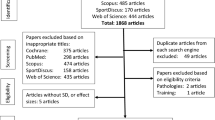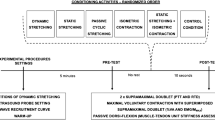Abstract
Purpose
Effective recovery from muscle fatigue, especially during rest intervals between periods of high-intensity activity, is important to ensure optimal subsequent performance. Stretching and icing are two types of treatment used for muscle recovery in such situations. However, their effectiveness remains unclear because of a lack of adequate evidence and/or discrepant results of previous studies. We performed a study to elucidate the effects of stretching and icing on muscle fatigue in subjects performing alternating muscle contraction and rest.
Methods
Sixteen healthy male subjects aged 21–27 years were evaluated. Each subject performed repeated isometric muscle contraction exercises that involved lifting and holding a dumbbell to induce muscle fatigue. Four treatments were performed during the rest periods between isometric muscle contraction: static stretching, ballistic stretching, no stretching, or icing. Electromyography and relative muscle oxygen saturation measurements were performed during the exercises. Muscle fatigue was indirectly estimated by the decline in the median frequency of the electromyographic signal.
Results
Stretching between alternate isometric muscle contraction exercises resulted in a significantly lower median frequency of the electromyographic signal than did no stretching. There was no significant difference in the change in the median frequency between static and ballistic stretching. Conversely, icing between alternate exercises did not decrease the median frequency.
Conclusions
Stretching, whether static or ballistic, is not beneficial for recovery from muscle fatigue and may actually inhibit recovery. Icing may more effectively induce such recovery and thus may be a better choice between the two treatment techniques.




Similar content being viewed by others
Abbreviations
- ANOVA:
-
Analysis of variance
- EMG:
-
Electromyography
- IMC:
-
Isometric muscle contraction
- MF:
-
Median frequency
- MVC:
-
Maximum isometric voluntary contraction force
- RMSO2 :
-
Relative muscle oxygen saturation
- UOEH:
-
University of Occupational and Environmental Health
References
ACSM (2009) ACSM’s guidelines for exercise testing and prescription, 8th edn. Lippincott Williams & Wilkins, Philadelphia, pp 171–174
Anderson RA, Anderson JE (2010) Stretching: 30th, anniversary edn. Shelter Publications Inc., Bolinas, pp 8–14
Behm DG, Chaouachi A (2011) A review of the acute effects of static and dynamic stretching on performance. Eur J Appl Physiol 111(11):2633–2651
Bleakley C, McDonough S, MacAuley D (2004) The use of ice in the treatment of acute soft-tissue injury—a systematic review of randomized controlled trials. Am J Sports Med 32(1):251–261
Cifrek M, Medved V, Tonkovic S, Ostojic S (2009) Surface EMG based muscle fatigue evaluation in biomechanics. Clin Biomech 24(4):327–340
De Luca CJ (1993) The use of surface electromyography in biomechanics. J Appl Biomech 13(2):135–163
Decoster LC, Cleland J, Altieri C, Russell P (2005) The effects of hamstring stretching on range of motion: a systematic literature review. J Orthop Sports Phys Ther 35:377–387
Ferretti G (1992) Cold and muscle performance. Int J Sports Med 13:S185–S187
Fowles JR, Sale DG, MacDougall JD (2000) Reduced strength after passive stretch of the human plantarflexors. J Appl Physiol 89:1179–1188
Herbert RD (2007) de Noronha M (2007) Stretching to prevent or reduce muscle soreness after exercise. Cochrane Database Syst Rev 4:1–31
Jakeman JR, Macrae R, Eston R (2009) A single 10-min bout of cold-water immersion therapy after strenuous plyometric exercise has no beneficial effect on recovery from the symptoms of exercise-induced muscle damage. Ergonomics 52(4):456–460
Kay AD, Blazevich AJ (2009) Moderate-duration static stretch reduces active and passive plantar flexor moment but not Achilles tendon stiffness or active muscle length. J Appl Physiol 106:1249–1256
Mannion AF, Dolan P (1994) Electromyographic median frequency changes during isometric contraction of the back extensors to fatigue. Spine 19(11):1223–1229
McHugh MP, Cosgrave CH (2010) To stretch or not to stretch: the role of stretching in injury prevention and performance. Scand J Med Sci Sports 20(2):169–181
Merletti R, Sabbahi MA, De Luca CJ (1984) Median frequency of the myoelectric signal. Effects of muscle ischemia and cooling. Eur J Appl Physiol Occup Physiol 52(3):258–265
Morse CI, Degens H, Seynnes OR, Maganaris CN, Jones DA (2008) The acute effect of stretching on the passive stiffness of the human gastrocnemius muscle tendon unit. J Physiol 586(1):97–106
Pointon M, Duffield R, Cannon J, Marino FE (2011) Cold application for neuromuscular recovery following intense lower-body exercise. Eur J Appl Physiol 111(12):2977–2986
Power K, Behm D, Cahill F, Carroll M, Young W (2004) An acute bout of static stretching: effects on force and jumping performance. Med Sci Sports Exerc 36:1389–1396
Robson-Ansley PJ, Gleeson M, Ansley L (2009) Fatigue management in the preparation of Olympic athletes. J Sports Sci 27(13):1409–1420
Shrier I (2004) Does stretching improve performance? A systematic and critical review of the literature. Clin J Sports Med 14:267–273
Sugawara H, Shimose R, Tadano C, Muro M (2012) Skin cold stimulation of the dermatome modulates activation of the quadriceps. J Phys Ther Sci 24(2):169–174
Torres JB, Conceição MCSC, Sampaio AO, Dantas EHM (2009) Acute effects of static stretching on muscle strength. Biomed Hum Kinet 1:52–55
Verducci FM (2000) Interval cryotherapy decreases fatigue during repeated weight lifting. J Athl Train 35(4):422–426
Acknowledgments
We sincerely thank all of the following undergraduate students who actively supported the performance of the study measurements: T. Morisaki, T. Shoji, N. Ishii, J. Shuto, Y. Sakakibara, M. Yuhki, F. Aruga, and Mr. H. Togami who was a research associate of Shared-Use Research Center, UOEH.
Conflict of interest
The authors have no conflict of interest directly relevant to the content of this article.
Author information
Authors and Affiliations
Corresponding author
Additional information
Communicated by Michael Lindinger.
Rights and permissions
About this article
Cite this article
Eguchi, Y., Jinde, M., Murooka, K. et al. Stretching versus transitory icing: which is the more effective treatment for attenuating muscle fatigue after repeated manual labor?. Eur J Appl Physiol 114, 2617–2623 (2014). https://doi.org/10.1007/s00421-014-2983-x
Received:
Accepted:
Published:
Issue Date:
DOI: https://doi.org/10.1007/s00421-014-2983-x




